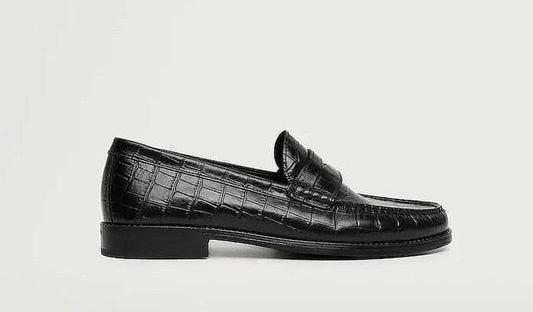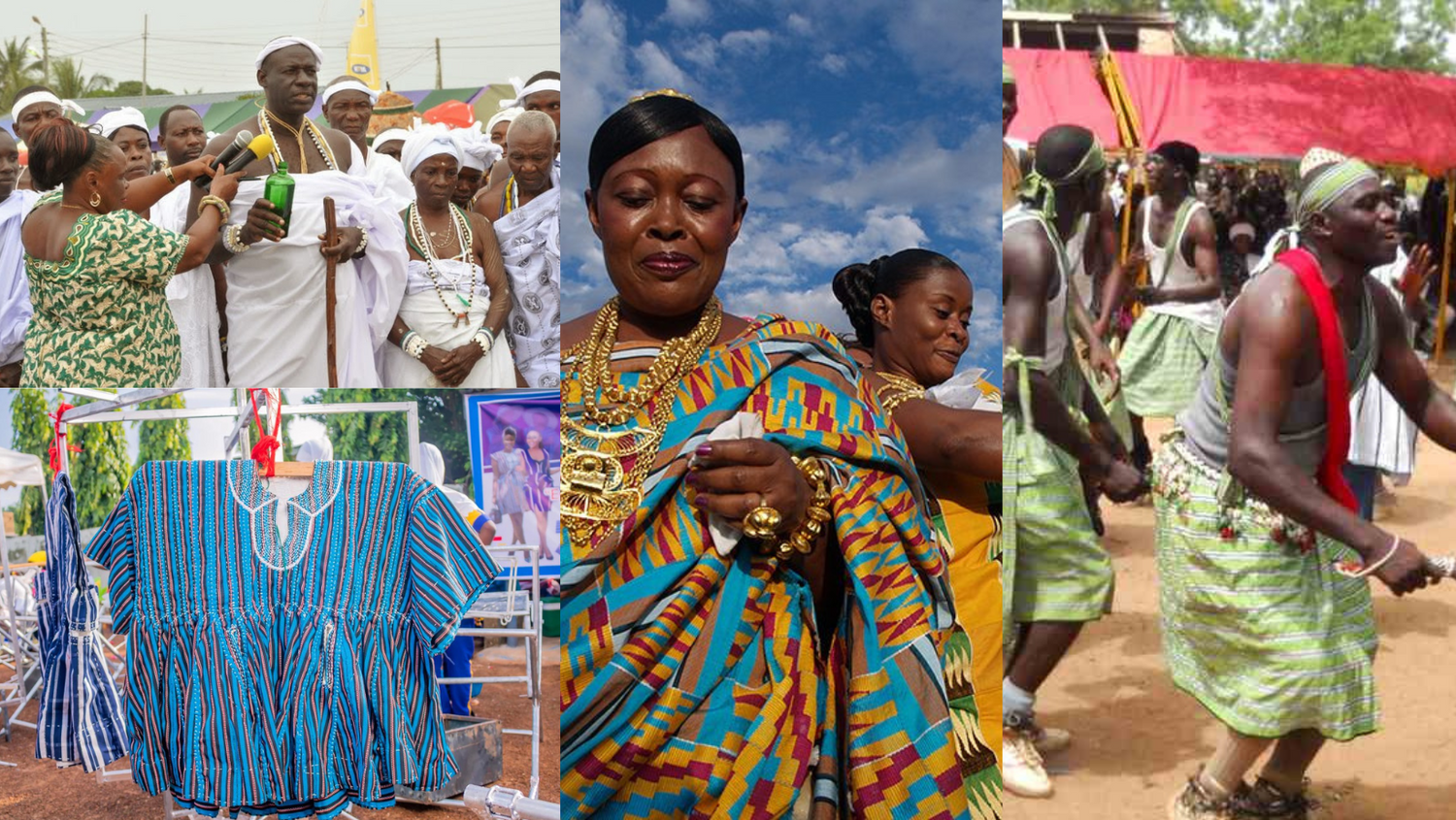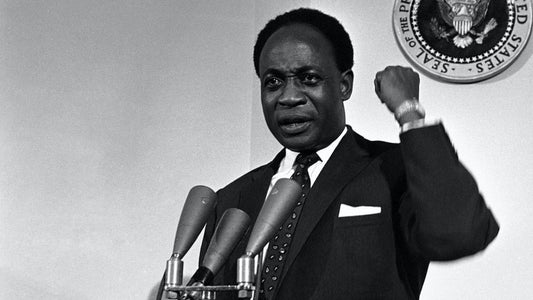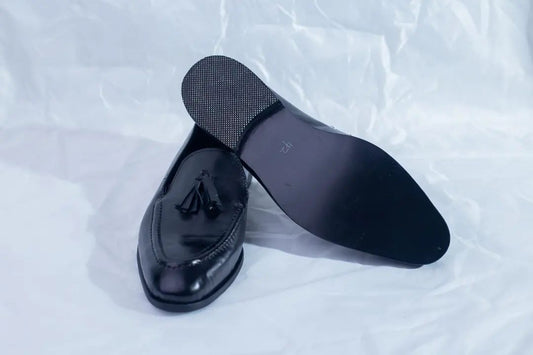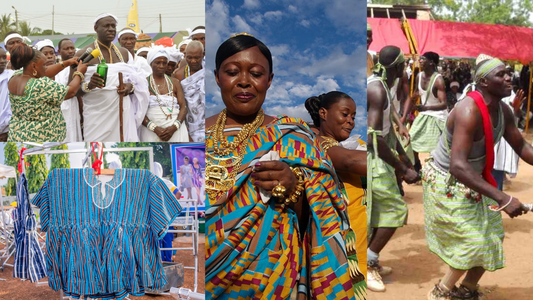The Ghanaian Fashion has a vibrant fiber art that weaves together tradition, culture and creativity. Since the beginning of time, over generation and time, Ghanaian fashion has undergone evolution, transcending various facets of culture and style. Let us take you on a fascinating journey through the time as we delve into the rich fashion heritage of Ghana.

The Rich Kente(Kete). Source: Google
Ghanaian fashion can be traced as far back as precolonial time, Ghana is blessed with different and diverse culture and people, and each of these cultures have a representation through fashion. From the iconic Kente cloth of the Ashanti to the vibrant Kete fabric of the Anlo and the distinctive Gonja cloth of Northern Ghana, these indigenous textiles stand as symbols of cultural heritage and artistic craftsmanship.
Within the diverse cultural landscape of Ghana, the fabrics known as Kente and Kete hold a special place, each with its own unique history and significance. While the Akans and the Ewes may have different narratives surrounding the origins of these fabrics, their shared heritage and intricate weaving techniques have cemented their position as cherished symbols of Ghanaian culture.
Kete, as referred to by the Ewes of the Volta Region, carries a captivating etymology that sheds light on the fabric's creation process. The word "Kete" derives from "ke" meaning "open or spread" and "te" meaning "tight or press." This name aptly captures the essence of weaving the cloth, where the weft is opened, "ke," and then tightly pressed, "te," as it is passed through. This meticulous process is repeated until the fabric takes shape, resulting in the beautiful Kete cloth.
On the other hand, the Akans have their own history surrounding the renowned Kente cloth. Handwoven by skilled Akans in the Ashanti, Eastern, and Brong-Ahafo regions. The name "Kente" itself is derived from the term "Kenten," which means basket. As the Akan history has it. This name pays homage to the intricate weaving techniques employed to craft the cloth, resembling the interlacing patterns found in traditional baskets. The indigenous Ashanti people referred to Kente as "Nwentoma," meaning a cloth that is woven with care and artistry.
While there are differing accounts, what remains undisputed is the rich cultural heritage that Kente carries, spanning precolonial times. The intricate patterns and vibrant colors of Kente have made it an iconic symbol of Ghanaian identity, recognized worldwide for its exquisite craftsmanship and symbolic meanings.
Despite the varying historical perspectives, both Kente and Kete fabrics have become integral parts of Ghana's textile heritage. These fabrics showcase the immense talent and artistry of Ghanaian weavers, who have honed their skills through generations, passing down their knowledge and techniques to preserve these cherished traditions.
Whether it is the Akans' Kente or the Ewes' Kete, these fabrics hold a special place in Ghanaian society, worn proudly during important cultural ceremonies and celebrations. They serve as a tangible link to Ghana's past, connecting present generations with their ancestors and embodying the resilience and creativity of the Ghanaian people.
In the tapestry of Ghana's cultural heritage, the threads of Kente and Kete intertwine, representing not only the art of weaving but also the stories, traditions, and pride of the nation. The intricate process of creating these fabrics reflects the dedication and skill of Ghanaian artisans, while the vibrant patterns and colors serve as visual storytellers, conveying the richness of Ghanaian culture.
Every color within the intricate patterns of Kente holds its own deep spiritual, royal, and social significance and it is believed that the progress and development of Sub-Saharan fashion owe much to the influence of Ghana and its illustrious Kente cloth.

The Gonja Fabric. Source: Wikimedia commons
In the realm of traditional Ghanaian clothing, where Kente and Kete often take the spotlight, there is a fabric known as Gonja cloth that holds a special place in the fashion heritage of Northern Ghana. Gonja cloth, a thick striped cotton fabric, serves as the primary material for creating the iconic smock garment, locally known as "fugu."
The production of Gonja cloth involves a meticulous process carried out by skilled artisans. Handpicked cotton is carefully dyed and woven by hand, resulting in long, narrow strips of fabric measuring about four inches wide. Typically, the pattern adorning this cloth features blue/black and white stripes, creating a visually striking aesthetic. These fabric strips are then either sewn together or sold in rolls, ready to be transformed into the distinguished smock garment.
While the smock is predominantly worn by men, there are also versions tailored for women. The garment itself resembles a shirt, with embroidered embellishments adorning the neckline and occasionally the front.
The history of the smock in Northern Ghana is deeply rooted in cultural exchange and trade. While various ethnic groups, including the Moshie, Kokomba, Dagomba, Mamprusi, Lobi, and Gonja, are involved in its production, the art itself was not originally exclusive to the region. According to Northern tradition, the introduction of smock fabric can be traced back to the Moshie people, who acquired it through trade with Ouagadougou in what is now Burkina Faso. The fabric was exchanged for a range of essential goods, such as kola nuts, millets, yam, rice, and guinea fowl.
Key weaving areas for the smock include Bolgatanga, Daboya, Tamale, Gushegu, Kpatinga, Yendi, Bawku, and Navrongo. Studying the production, aesthetics, form, function, and cultural significance of the smock remains essential in deepening our understanding of Ghana's ethnic textile heritage.
The Gonja cloth and the smock it creates are not just garments; they represent an enduring cultural tradition that has been passed down through generations. These textiles play a crucial role in preserving, presenting, and promoting the vibrant culture of Northern Ghana. By embracing the artistry and significance of the smock, we honor the craftsmanship, history, and identity woven into each thread, connecting us to the diverse and fascinating tapestry of Ghanaian fashion.
Adorning with Adinkra: Another significant aspect of Ghanaian fashion from precolonial times is the use of Adinkra symbols. These intricate patterns, traditionally worn by the Akan people, are stamped onto fabric using carved calabash stamps. Adinkra symbols communicate wisdom, proverbs, and moral values, serving as a visual language that resonates throughout Ghanaian culture.
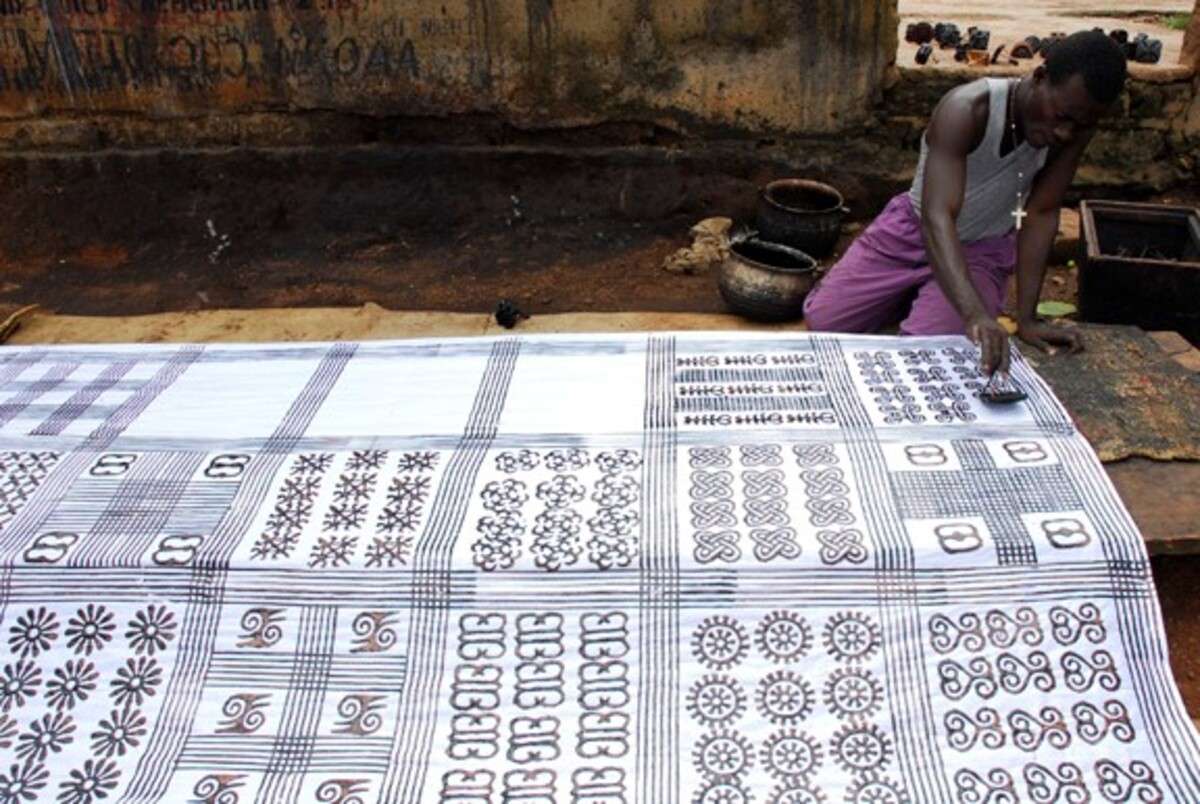
A typical precolonial Adinkra fabric. Source: Google
Influence of Colonial Era: The arrival of European colonizers in Ghana brought new fabrics and styles that merged with traditional attire. Wax prints, also known as "African prints" or "Ankara," gained popularity. Although originally produced in Europe, Ghanaians adopted these fabrics and infused them with local aesthetics, resulting in unique combinations of vibrant patterns and bold colors.
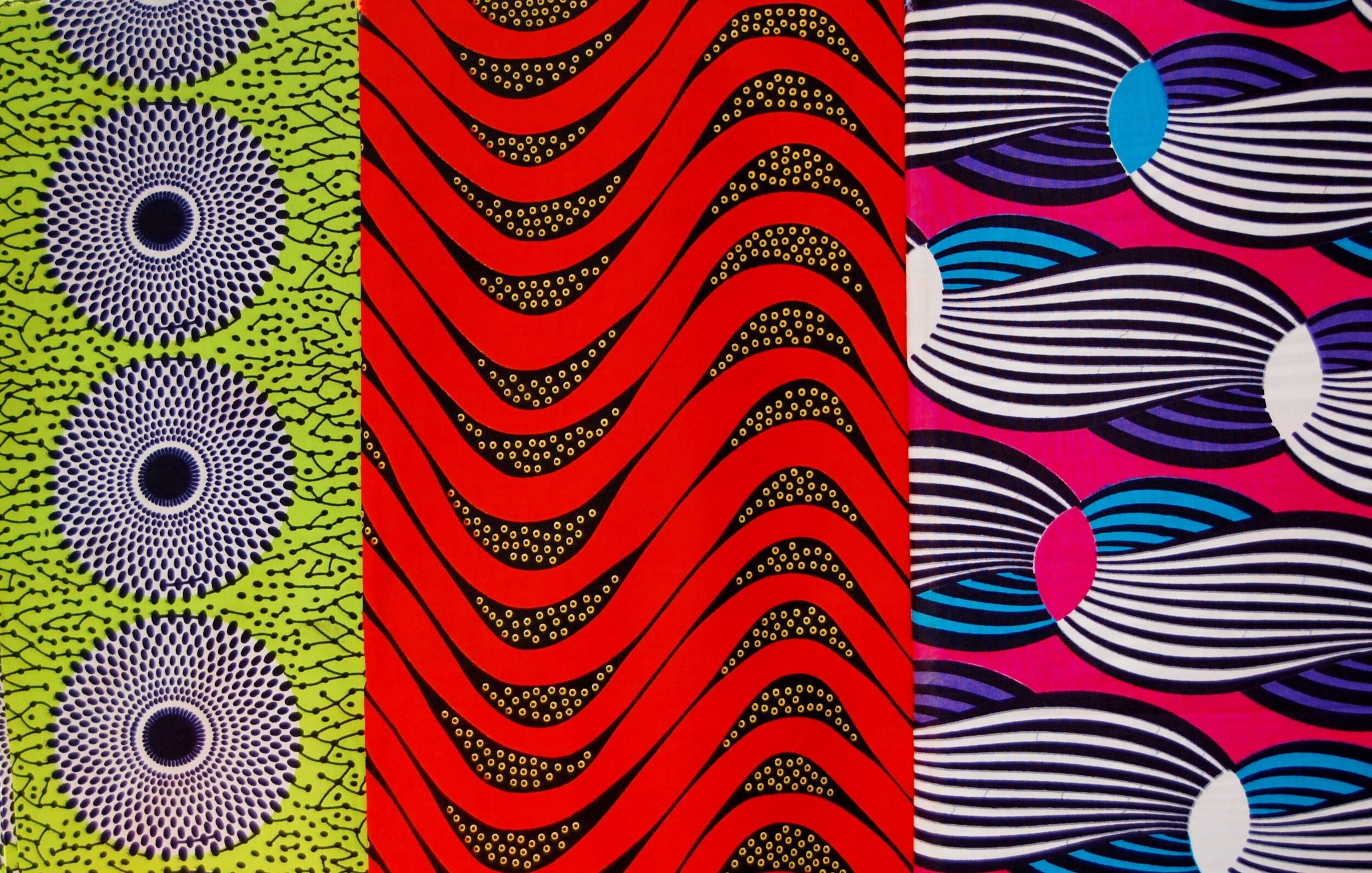
The Ankara Fabrics. Source: Pinterest
Emergence of Contemporary Ghanaian Fashion: In the early 2000s till date the Ghanaian fashion experienced a remarkable resurgence. Talented designers and entrepreneurs have emerged over the period, blending traditional elements with modern silhouettes. Their captivating collections celebrate Ghana's cultural heritage while making a mark on the global fashion stage. By showcasing Ghanaian craftsmanship, these fashion visionaries contribute to the economic development of the country's fashion industry.
Promoting Sustainable Fashion: Ghanaian fashion goes beyond aesthetics by embracing sustainability and ethical practices. The traditional textile industry, such as the handweaving of Kente and the production of Batik fabrics, reflects eco-friendly principles. Additionally, there is a growing movement towards using locally sourced materials and promoting fair trade practices. These initiatives empower local artisans, preserve traditional craftsmanship, and contribute to a more sustainable fashion industry. Now a lot of the young entrepreneurs have found ways of using waste fabric and plastics to make footwears and other fashion accessories, as a means to contributing sustainable development and circular economy.

Rich Ghanaian Fashion Heritage. Put together by Hilda Asiedu on Canva.
Celebrating Diversity: Ghanaian fashion embraces the country's diversity. Each region within Ghana showcases its distinctive fashion customs, highlighting the unique nuances of different ethnic groups. From the intricate smocks of the northern regions to the brightly colored kaba and slit of the southern parts, Ghanaian fashion celebrates the individuality of each community, fostering unity and pride.
Ghanaian fashion is a captivating blend of tradition and innovation, preserving cultural heritage while embracing contemporary creativity. From the ancient artistry of Kente to the modern designs gracing international runways, Ghanaian fashion weaves a narrative of resilience, pride, and enduring spirit. As Ghana continues to make its mark on the global fashion scene, its sartorial heritage serves as a constant source of inspiration, connecting past, present, and future generations.
Ahofade stands firmly committed to upholding and advancing the rich legacy of Ghanaian fashion. With a deep appreciation for the cultural heritage embedded within Ghana's fashion industry, we actively promote and support the production of locally made in Ghana goods, fostering the growth of young entrepreneurs in this sector.


